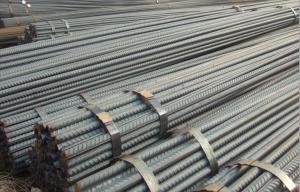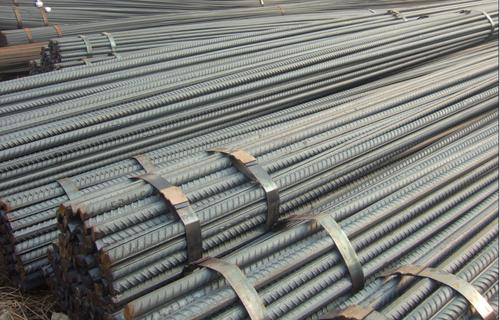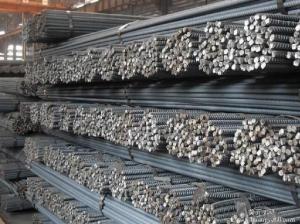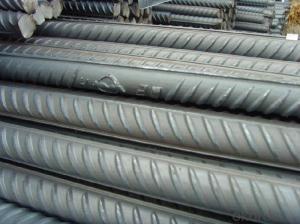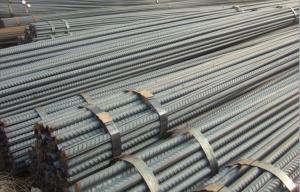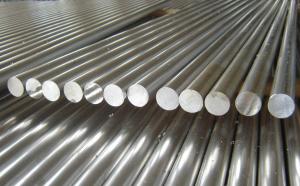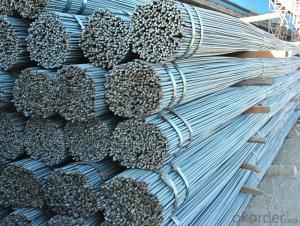Deformed Bar 6MM-50MM BS4449 B500B Or GB HRB
- Loading Port:
- China Main Port
- Payment Terms:
- TT or LC
- Min Order Qty:
- -
- Supply Capability:
- -
OKorder Service Pledge
OKorder Financial Service
You Might Also Like
Product Description:
OKorder is offering high quality Deformed Bar 6MM-50MM BS4449 B500B Or GB HRB at great prices with worldwide shipping. Our supplier is a world-class manufacturer of steel, with our products utilized the world over. OKorder annually supplies products to European, North American and Asian markets. We provide quotations within 24 hours of receiving an inquiry and guarantee competitive prices.
Product Applications:
Deformed bar is widely used in buildings, bridges, roads and other engineering construction. Big to highways, railways, bridges, culverts, tunnels, public facilities such as flood control, dam, small to housing construction, beam, column, wall and the foundation of the plate, deformed bar is an integral structure material. With the development of world economy and the vigorous development of infrastructure construction, real estate, the demand for deformed bar will be larger and larger
Product Advantages:
OKorder's Deformed Bar 6MM-50MM BS4449 B500B Or GB HRB are durable, strong, and resist corrosion, exact size, regular package, chemical and mechanical properties are stable.
Main Product Features:
· Premium quality
· Prompt delivery & seaworthy packing (30 days after receiving deposit)
· Corrosion resistance
· Can be recycled and reused
· Mill test certification
· Professional Service
· Competitive pricing
Product Specifications:
Manufacture: Hot rolled
Grade: BS4449
Certificates: ISO, SGS, BV, CIQ
Diameter: 6mm,8mm,10mm,12mm,14mm,16mm,18mm,20mm,
22mm,25mm,28mm,32mm,36mm,40mm,50mm
Length: 6M, 9M,12M or as required
Packaging: Export packing, nude packing, bundled
Chemical Composition: (Please kindly find our chemistry of our material based on HRB500 as below for your information)
Grade | Technical data of the original chemical composition (%) | ||||||
C | Mn | Si | S | P | V | ||
HRB400 | ≤0.25 | ≤1.60 | ≤0.80 | ≤0.045 | ≤0.045 | 0.04-0.12 | |
Physical capability | |||||||
Yield Strength (N/cm²) | Tensile Strength (N/cm²) | Elongation (%) | |||||
≥400 | ≥570 | ≥14 | |||||
Theoretical weight and section area of each diameter as below for your information:
Diameter(mm) | Section area (mm²) | Mass(kg/m) | Weight of 12m bar(kg) |
6 | 28.27 | 0.222 | 2.664 |
8 | 50.27 | 0.395 | 4.74 |
10 | 78.54 | 0.617 | 7.404 |
12 | 113.1 | 0.888 | 10.656 |
14 | 153.9 | 1.21 | 14.52 |
16 | 201.1 | 1.58 | 18.96 |
18 | 254.5 | 2.00 | 24 |
20 | 314.2 | 2.47 | 29.64 |
22 | 380.1 | 2.98 | 35.76 |
25 | 490.9 | 3.85 | 46.2 |
28 | 615.8 | 4.83 | 57.96 |
32 | 804.2 | 6.31 | 75.72 |
36 | 1018 | 7.99 | 98.88 |
40 | 1257 | 9.87 | 118.44 |
50 | 1964 | 15.42 | 185.04 |
FAQ:
Q1: Why buy Materials & Equipment from OKorder.com?
A1: All products offered byOKorder.com are carefully selected from China's most reliable manufacturing enterprises. Through its ISO certifications, OKorder.com adheres to the highest standards and a commitment to supply chain safety and customer satisfaction.
Q2: How do we guarantee the quality of our products?
A2: We have established an advanced quality management system which conducts strict quality tests at every step, from raw materials to the final product. At the same time, we provide extensive follow-up service assurances as required.
Q3: How soon can we receive the product after purchase?
A3: Within three days of placing an order, we will begin production. The specific shipping date is dependent upon international and government factors, but is typically 7 to 10 workdays.

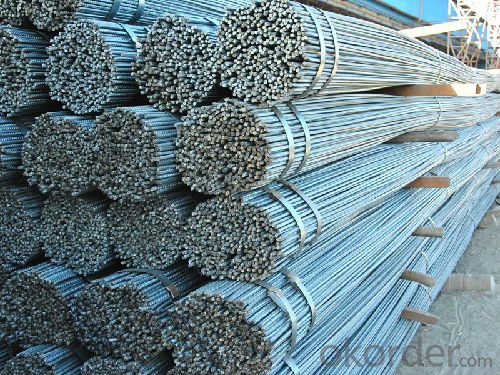
- Q: How are steel rebars cut and shaped on-site?
- Steel rebars are commonly cut and shaped on-site using various tools and techniques. The process typically involves the following steps: 1. Measurement: The rebars are first measured according to the required length and shape. This is done by using measuring tapes, rulers, or other measuring devices. 2. Marking: Once the measurements are taken, the rebars are marked at the appropriate points using chalk or a marker. These marks serve as guidelines for cutting and shaping the rebars accurately. 3. Cutting: The rebars are then cut along the marked lines using mechanical or hydraulic cutting tools. Some commonly used tools for cutting rebars include rebar cutters, angle grinders with cutting discs, or portable band saws. These tools are specifically designed to handle the high strength of steel rebars and ensure clean and precise cuts. 4. Shaping: After the rebars are cut to the desired lengths, they can be further shaped as needed. This shaping process involves bending the rebars into specific angles or curves. Manual rebar benders or electric rebar bending machines are commonly used for this purpose. These tools allow for accurate shaping of the rebars, ensuring they fit the required structural design. 5. Tying: Once the rebars are cut and shaped, they are often tied together using wire or rebar tying machines. This tying process helps to secure the rebars in place and maintain the desired positioning within the concrete structure. It is important to note that the cutting and shaping of rebars on-site require skilled workers who are trained in handling the tools and following proper safety precautions. These workers must also have a good understanding of the structural requirements and be able to interpret construction drawings to accurately cut and shape the rebars according to the project specifications.
- Q: What are the different types of steel rebars available for different applications?
- There are several types of steel rebars available for different applications, including carbon steel rebars, epoxy-coated rebars, stainless steel rebars, and galvanized rebars. Each type has its own unique properties and benefits, making them suitable for various construction projects based on factors like corrosion resistance, strength requirements, and environmental conditions.
- Q: What are the different methods of protecting steel rebars from fire?
- There are several methods available for protecting steel rebars from fire. One common approach is to use fire-resistant coatings or paints that can be applied directly to the rebars. These coatings create a barrier that helps to prevent the steel from reaching its critical temperature during a fire. Another method is to encase the rebars in a fire-resistant material, such as concrete, which acts as a protective layer. Additionally, fireproofing sprays or intumescent coatings can be used to provide insulation and slow down the transfer of heat to the rebars. Finally, ensuring proper spacing and cover of rebars within the concrete structure can also offer some level of fire protection.
- Q: What is the average weight of steel rebars per meter?
- The weight of steel rebars per meter can differ based on the particular size and type of rebar utilized. Nevertheless, as a general rule, a commonly used rebar size like a #4 (with a diameter of 1/2 inch) generally weighs approximately 0.668 kilograms per meter. Conversely, a #8 rebar (with a diameter of 1 inch) can weigh roughly 2.67 kilograms per meter. To obtain the precise weight of steel rebars per meter for a specific size and type, it is crucial to consult the manufacturer or refer to a reliable source.
- Q: How do steel rebars contribute to the overall seismic resistance of a structure?
- The overall seismic resistance of a structure is significantly enhanced by the presence of steel rebars. When an earthquake happens, the structure is subjected to strong lateral forces and vibrations. If these forces are not properly addressed, the structure may deform or even collapse. To prevent this, reinforcement bars, also known as steel rebars, are utilized to strengthen and stabilize concrete structures. One of the main advantages of steel rebars is their ability to absorb and distribute seismic energy. During an earthquake, the rebars act as a backbone within the concrete, effectively absorbing the seismic forces and preventing excessive deformation of the structure. By distributing the energy throughout the entire structure, the rebars reduce localized stress and prevent concentrated damage. Additionally, steel rebars enhance the ductility of a structure. Ductility refers to a material's ability to deform without breaking. When an earthquake occurs, the ground shakes, causing the structure to sway. Steel rebars improve the ductility of concrete by providing an extra pathway for the energy to dissipate. This allows the structure to absorb and release the seismic energy by deforming in a controlled manner, ensuring its integrity and minimizing damage. Furthermore, steel rebars increase the tensile strength of concrete. While concrete is strong in compression, it is weak in tension. Steel rebars counteract this weakness by providing tensile strength to the structure. When an earthquake happens, the rebars bear the tensile forces and prevent the concrete from cracking or collapsing under tension. This reinforcement ensures that the structure remains stable and resilient during seismic events. In conclusion, steel rebars play a crucial role in enhancing the overall seismic resistance of a structure. They absorb and distribute seismic energy, improve the ductility of concrete, and increase its tensile strength. By including steel rebars in the construction process, the structure becomes capable of withstanding the lateral forces and vibrations caused by earthquakes, reducing the risk of damage or collapse.
- Q: How are steel rebars different from other types of reinforcement?
- The composition and strength of steel rebars set them apart from other types of reinforcement. Unlike fiberglass or carbon fiber, which are commonly used for reinforcement, steel rebars are made of steel, giving them exceptional strength and durability. One notable distinction between steel rebars and other reinforcement types is their capacity to withstand high tensile forces. Steel possesses a high tensile strength, allowing it to resist stretching or being pulled apart. This characteristic makes steel rebars ideal for reinforcing concrete structures that experience significant tensile loads, such as bridges, buildings, and highways. Another unique feature of steel rebars is their ability to bond effectively with concrete. The ridges or deformations on the rebars' surface enhance adhesion between the steel and concrete, facilitating efficient load transfer. This bond ensures that the concrete and steel work together as a composite material, enhancing the overall strength and structural integrity of the reinforced concrete structure. Steel rebars also offer versatility in terms of shape and size. They are available in various diameters, lengths, and shapes, including round, square, and deformed. This variety allows engineers to select the most suitable rebar type based on the specific requirements of the construction project. Moreover, steel rebars exhibit high resistance to corrosion, particularly when properly coated or protected. This corrosion resistance ensures the longevity and durability of the reinforced concrete structure, even in harsh environments or exposure to moisture. In conclusion, steel rebars stand out from other reinforcement types due to their exceptional strength, ability to withstand high tensile forces, excellent bond with concrete, versatility in shape and size, and resistance to corrosion. These qualities make steel rebars the most commonly used and preferred choice for reinforcing concrete structures in the construction industry.
- Q: Can steel rebars be used in parking structure construction?
- Yes, steel rebars can be used in parking structure construction. Steel rebars are commonly used in reinforced concrete structures, providing strength and durability to the construction. In parking structures, where heavy loads and traffic are expected, the use of steel rebars is critical to ensure the integrity and stability of the structure. These rebars are typically placed in the concrete slabs, walls, and columns of the parking structure, enhancing its load-bearing capacity and resistance to forces such as compression, tension, and bending. Additionally, steel rebars can also be used to reinforce the ramps, driveways, and other areas that require additional support in parking structures. Overall, the use of steel rebars is essential in parking structure construction to meet the required safety standards and ensure the longevity of the facility.
- Q: Are there any specific guidelines for storing and handling steel rebars?
- Yes, there are specific guidelines for storing and handling steel rebars. Here are some important points to consider: 1. Storage: Steel rebars should be stored in a clean, dry, and well-ventilated area to prevent corrosion. They should be stacked on timber or other suitable materials to keep them off the ground and avoid contact with moisture. 2. Handling: Steel rebars should be handled with care to prevent any damage or bending. It is recommended to use appropriate equipment such as cranes, forklifts, or strong hooks to lift and move rebars. Avoid dragging or dropping them, as it can result in deformations and weaken their structural integrity. 3. Bundling: Rebars should be properly bundled and tied together using steel wires or straps to prevent them from rolling or shifting during storage or transportation. This ensures their stability and reduces the risk of accidents. 4. Separation: Different sizes and types of rebars should be separated and clearly labeled to avoid confusion during construction. This helps in easily identifying and using the required rebar as per the structural plans. 5. Protection: Rebars should be protected from exposure to moisture, rain, snow, and other weather elements. If rebars are stored outdoors, waterproof covers or tarps should be used to shield them and prevent rust formation. 6. Inspection: Regular inspections should be conducted to identify any signs of corrosion, damage, or bending. Any defective or compromised rebars should be removed and replaced to ensure the structural integrity of the construction project. 7. Transportation: During transportation, rebars should be securely fastened and loaded onto suitable vehicles to prevent movement or falling off. Adequate padding and tie-downs should be used to protect rebars from damage and ensure safe transportation. It is crucial to follow these guidelines to maintain the quality, durability, and safety of steel rebars throughout their storage and handling process.
- Q: How do steel rebars contribute to the overall resistance against natural disasters?
- Steel rebars contribute to the overall resistance against natural disasters in various ways. Firstly, steel rebars are extensively used in reinforced concrete structures such as buildings, bridges, and dams, which are designed to withstand natural disasters like earthquakes and hurricanes. The addition of steel rebars increases the structural integrity of these concrete elements, making them more resistant to the forces exerted by such disasters. During earthquakes, the flexible nature of steel rebars allows them to absorb and distribute the seismic energy throughout the structure. This helps in dissipating the destructive forces and reducing the chances of collapse or severe damage. The presence of steel rebars also enhances the ductility of reinforced concrete structures, which means they can deform and flex without breaking, thus improving their overall resilience against seismic events. In the case of hurricanes or strong winds, steel rebars provide additional strength and stability to concrete structures. They act as reinforcement, preventing the concrete from cracking or crumbling under the pressure of high winds. The combination of the tensile strength of steel and the compressive strength of concrete creates a robust and durable structure that can withstand the powerful forces generated by hurricanes. Furthermore, steel rebars play a crucial role in the construction of flood-resistant structures. During flooding events, the strength and corrosion resistance of steel rebars ensure the structural integrity of buildings and other infrastructure, preventing them from being severely damaged or washed away. The use of steel rebars in flood-prone areas helps in creating resilient structures that can withstand the erosive forces of water and remain intact. Overall, steel rebars significantly contribute to the overall resistance against natural disasters by enhancing the strength, durability, and flexibility of concrete structures. Their presence improves the structural integrity and resilience of buildings, bridges, and other infrastructure, making them more capable of withstanding the destructive forces unleashed by earthquakes, hurricanes, and floods.
- Q: Are there any alternatives to steel rebars in construction?
- Yes, there are several alternatives to steel rebars in construction. Some common alternatives include fiberglass rebars, carbon fiber rebars, and basalt rebars. These alternative materials offer advantages such as being corrosion-resistant, lightweight, and having high tensile strength. Additionally, some construction projects may also utilize alternatives like bamboo or plastic rebars, depending on the specific requirements and conditions of the project.
Send your message to us
Deformed Bar 6MM-50MM BS4449 B500B Or GB HRB
- Loading Port:
- China Main Port
- Payment Terms:
- TT or LC
- Min Order Qty:
- -
- Supply Capability:
- -
OKorder Service Pledge
OKorder Financial Service
Similar products
Hot products
Hot Searches
Related keywords
